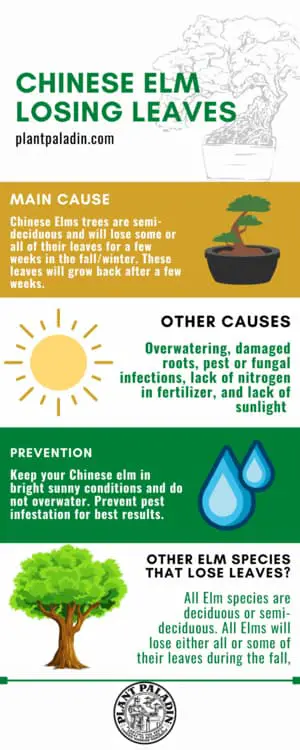This website is supported by its readers. If you click one of my links I may earn a commission. I am also a participant in the Amazon affiliates program and I will also earn a commission from qualified purchases.
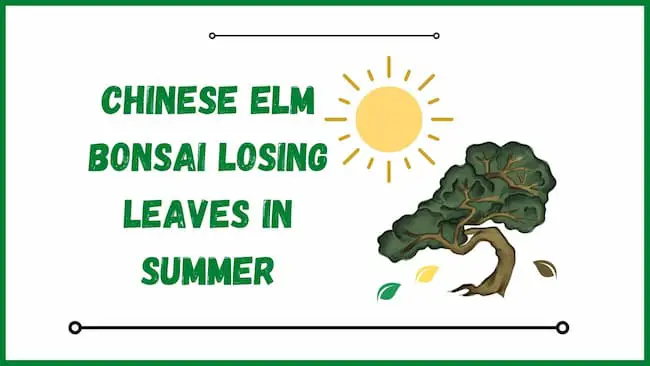
Chinese Elm bonsai trees are one of the most accessible and beginner-friendly bonsai trees. While these trees are easy to care for, if the trees start losing leaves in summer, should you start to panic? Why is your Chinese Elm bonsai losing leaves in the summer?
Chinese Elm bonsai trees should not lose leaves in the summer. If your Chinese Elm bonsai loses leaves in summer, it is likely due to lack of light, overwatering, keeping the tree at the wrong temperature, or a fungal, mold, or bacterial infection.
Poor soil quality and underwatering can also lead to dropping leaves in summer.
So if you notice that your Chinese Elm Bonsai is losing leaves in the summer, what can you do to prevent it? Are there any occasions where Chinese Elm bonsai losing leaves is okay? Keep reading to find out more.
Just a quick heads up, over the past three years of running Plantpaladin, hundreds of people have asked for product recommendations. As such, You can find my favorite indoor bonsai tree here (link takes you to Bonsaiboy), my favorite outdoor bonsai tree (link takes you to Bonsaiboy), or have a look at all the products I recommend here.
Chinese Elm bonsai losing leaves in summer
So you’ve done the hard work and managed to plant your Chinese Elm bonsai tree in the early spring as recommended.
You hope to have a lovely easy summer with your bonsai as it enters its first real growing season, and then boom!
The leaves of your Chinese Elm start to drop off.
Falling leaves are all too familiar to me.
This happened when I purchased my first Chinese Elm bonsai.
So to figure out exactly why my Chinese Elm bonsai was losing its leaves in summer, I contacted a few tree experts and visited my local botanical garden to get some answers.
To ensure that this post was all up to date, I even surveyed 20 Plant Paladin readers to ensure you had the best post possible answer as to why your Chinese Elm bonsai was losing leaves in summer.
Why do Chinese Elm leaves fall off?
- While Chinese Elm trees are semi-deciduous ( meaning they lose their leaves for a few weeks through the year), this typically only occurs during the cooler months.
- If your Chinese Elm bonsai loses leaves during the summer, something is likely wrong with your tree care.
- The most common reasons are a lack of sunlight; these trees require between 4 to 8 hours of direct sunlight in the growing season.
- With most of us living in cooler, more mild climates, it can be easy for these trees not to get adequate sunlight.
- Other significant reasons for Chinese Elm bonsai losing leaves in summer include overwatering, which can prevent your tree from absorbing nutrients from the soil.
- Moving your Chinese Elm bonsai too frequently, keeping your bonsai at the wrong temperature, insect infestation, or bacterial or mold diseases are also common reasons for dropping leaves in Chinese Elm bonsai.
- Most of these symptoms can be reversed, meaning you can get your Chinese Elm bonsai back to prime health with some care and patience.
Chinese Elm bonsai losing leaves in summer – causes and solutions:
Now the above is quite a lot of information to take in, so to help make things a little easier, I’ve put together a table showing the significant reasons why your Chinese Elm bonsai is losing leaves:
Let’s explore these in more detail:
Cause | Solution |
Seasonality | Wait a few weeks and the tree should regrow it leaves |
Change of location | Wait a few weeks and the tree should regrow it leaves |
Lack of sunlight | Use a grow light or move outdoors to get 6 hours of sunlight per day. |
Overwatering | Plant in the ground to stop overwatering, only water when the topsoil is dry to touch. |
Lack of nitrogen | Invest in fertilizer with an equal N-P-K ratio |
Low humidity | Move outdoors or invest in humidifier/diffuser |
Damaged roots | Trim or remove roots |
Insect infestation | Natural or chemical positive |
Underwatering | Check topsoil daily for water requirements |
Excessive training | Refrain from wiring, pruning or cutting your tree for one year |
Poor potting soil | Repot your tree in a fresh inorganic potting soil mix |
Lack of sunlight
Without a doubt, if your Chinese Elm bonsai is losing leaves in the summer, the primary reason is simply a lack of direct sunlight.
Chinese Elm trees require at least 4 to 6 hours of direct sunlight in the summer growing season.
Sadly most of us live in climates that only get a few bright summer days in the year, so keep our bonsai indoors.
If you keep your Chinese Elm indoors, away from windows, there is a good chance that your tree does not have enough light to maintain its health.
Sunlight is essential for trees as it is where trees and other fauna get their food through photosynthesis.
A lack of sunlight will mean you Chinese Elms will start to make their process more efficient to reduce the amount of energy used.
If your Chinese Elm is not getting enough light, your tree will start to shed leaves that take up vital energy to maintain.
How to prevent it?
To prevent the leaves from falling from your Chinese Elm caused by a lack of sunlight, move your Chinese Elm to a spot with plenty of bright sunlight.
These trees require between 6 and 8 hours of first sunlight per day.
Keeping your tree indoors in a space with no windows will lead to disaster for your tree.
Instead, place your tree near a south or west-facing window for best results.
If you are hesitant about moving your tree, consider investing in LED artificial lights that contain the entire light spectrum.
These can provide your tree’s sunlight requirements and don’t break the bank to operate.
Should I move my Chinese Elm outdoors?
If lack of light is the main reason causing your leaves to drop, and you live in a climate that has bright warm summers, then consider moving your Chinese Elm bonsai outdoors.,
Chinese Elms are versatile and can thrive both in indoor and outdoor conditions.
I strongly advise moving your tree outdoors for a few weeks every few months to ensure they stay healthy and gain enough sunlight.
Changes in location
It can be easy to forget that Chinese Elm bonsai are living, breathing things.
If you imagine for a second that your Chinese Elm bonsai tree is a baby or toddler, and you keep moving it around like a newborn, it’s not going to be very happy.
The same goes for Chinese Elm bonsai, which like to be kept and maintained at a consistent temperature.
A common occurrence is if you have just purchased your Chinese Elm bonsai from a garden center.
Many reputable bonsai retailers such as Eastern Leaf or Herons Bonsai will have disclaimers when purchasing their trees that the tree’s leaves will partially or entirely fall off in the first few weeks.
Chinese Elm trees are not fixed furniture or faux trees but living, breathing trees and need a bit of time in most scenarios to acclimate to their new conditions.
For example, if you have purchased your Chinese Elm tree from the USA and are moving it into your home in the UK, your tree will take a few weeks to adapt to the changes in temperature, sunlight, and new soil conditions.
These stresses will naturally cause your tree’s leaves to fall as it gets to grips with its new conditions before sprouting new growth.
Typically this leaf fall will take between 5 and 6 weeks at the longest before the new leaves start to come through.
How to prevent it?
The best thing to prevent leaves from falling off from location change is to keep your Chinese Elm in the same place.
Place your Chinese Elm bonsai indoors in a south or west-facing window where it gets plenty of sunlight, and do not move the tree from this place for the duration of your Chinese Elm’s life.
Keeping at the wrong temperature
So similar to moving the tree too frequently or not providing enough sunlight, another primary reason for the leaves of your Chinese Elm bonsai tree falling off is simply keeping them at the wrong temperature.
Chinese Elm bonsai are tropical trees and t love to be kept in warmer conditions, typically between 60 degrees F and 100 degrees F.
If you keep your bonsai outdoors and live in a climate that rarely gets these temperatures in summer, you need to increase the temperature of the tree drastically.
Alternatively, it can be easy to blast the air conditioning indoors when it is super hot outdoors to create a cool environment.
If you keep your Chinese Elm bonsai indoors in the same room as the AC, be mindful that this too can impact the temperature of the tree.
Going from hot to very cool conditions in summer will likely have the same problem as changing the location of the bonsai in the point above.
How to prevent it?
To prevent this, aim to keep your Chinese Elm bonsai at the set temperature range of between 60F to 100F.
If you struggle to do so, aim to invest in mini heaters that will maintain your tree’s temperature year-round.
I’d also recommend keeping these trees indoors where you can manage the temperatures more quickly than if you keep them outdoors.
Finally, consider investing in something like a greenhouse where you can directly manage the bonsai tres temperature if you have the budget to do so.
Overwatering
Another primary reason your Chinese Elm bonsai tree loses leaves is simply overwatering the tree.
While many of us feel that underwatering is the major problem we make when it comes to our Chinese Elm bonsai in summer, overwatering is a lot more prevalent.
We often overcompensate the watering our trees, especially if we are about to go on vacation, and can end up often drowning the roots of our tree.
If not addressed, this can lead to mold infections or root rot.
The main signs that you will have overwatered your bonsai will be the leaves turning yellow before they drop off.
How to prevent it?
The excellent news about overwatering is that you can reverse it in most scenarios.
I’ve written two posts dedicated to the topic below:
But to summarise, prevent overwatering:
- Trim back any waterlogged roots
- Plant your tree in the ground outdoors so the soil can absorb the excess water.
- Dry out the dirt and roots of your Chinese Elm with a hairdryer
- Practice good watering etiquette.
- Only water when the topsoil of your Chinese Elms tree is dry to touch.
- Consider using rainwater where possible.
Water your Chinese Elm bonsai twice weekly in the spring, summer, and fall (depending on the conditions).
Water once every one to two weeks in the winter.
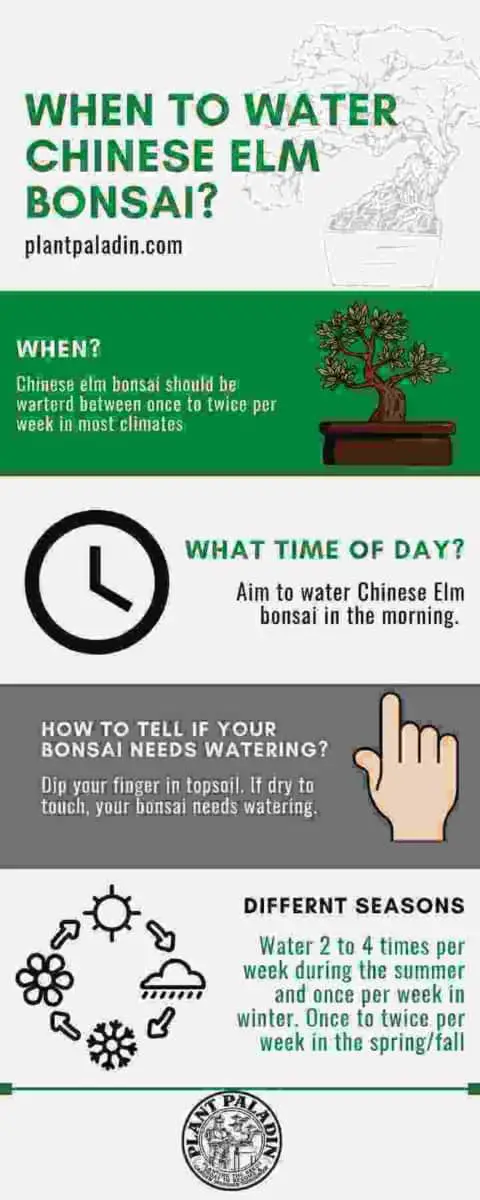
Underwatering
While overwatering is surprisingly more common in summer, underwatering is still an actual occurrence in Chinese Elm bonsai.
The most common symptoms are dry topsoil and leaves that will look dry and withered before they fall off.
Another significant surefire sign you have underwater in your Chinese Elm bonsai during the summer is dry branches and twigs that are brittle to touch.
How to prevent it?
Like overwatering, thankfully, there are a few things you can do to ensure you don’t underwater your tree.
I recommend checking your bonsai potting soil for dryness in the summer about two to three times per day.
If the topsoil is dry to touch, i.e., you put your index finger in the soil and feel no moisture, your Chinese Elm bonsai requires watering.
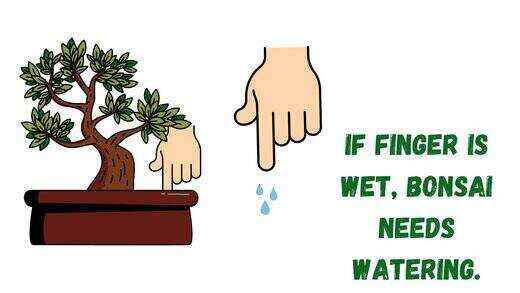
Especially important if you are going through a heatwave where it can be easy for your tree to get burnt.
I’d also recommend using bottom watering if you know there will be an extensive period of heat and sunlight for your Chinese Elm. Use a moisture or humidity tray to add moisture back to your ree only during these conditions.
Season | How much watering |
Spring | 1-2 times per week |
Summer | 2 to 4 times per week |
Autumn | 1 to 2 times per week |
Winter | Once per week/every two weeks |
Poor fertilizer quality
So while the above are the primary reasons why Chinese Elm bonsai can lose leaves in summer, there are a few other reasons that might not be obvious at first glance.
First up – poor fertilizer.
Chinese Elm bonsai can typically be fertilized once per month during the spring and summer.
If the N-P-K ratio is not balanced, it can have a massive impact on the tree’s health.
The big culprit here is usually a lack of Nitrogen in fertilizer which can result in your Chinese Elm bonsai dropping leaves.
How to prevent it?
The best way to prevent the Chinese Elm bonsai from losing leaves in summer from a lack of nitrogen in fertilizer is to add nitrogen back into the fertilizer.
The best way to do this is by using a Fertilizer with a balanced N-P-K ratio with equal parts of all the elements.
Alternately, other organic materials in fertilizer, such as coffee grounds, can also be undertaken.
Poor soil quality
Another primary reason your Chinese Elm bonsai may be losing leaves during the summer is poor soil quality.
Bonsai soil needs to have three key elements: good water retention, good moisture flow, and enough oxygen so that the tree roots can breathe.
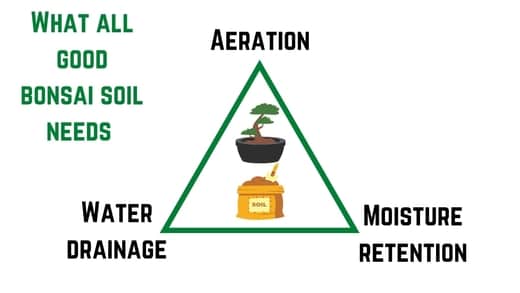
If these are lacking, then this can cause the tree to fail to absorb nutrients from the soil.
A lack of nutrients will force your tree to become more efficient and can result in your bonsai dropping leaves in the middle of summer.
How to prevent it?
Investing in a quality soil mix is the best way to prevent poor soil quality.
You can use both organic and inorganic soil mixes for Chinese Elm bonsai, but I find the following to be the best ratio for Chinese Elm bonsai trees:
50% Akadama, 25% volcanic lava rock, 25% pumice
Damaged roots
Damaged roots can (unfortunately) be commonplace when growing Chinese Elm bonsai.
Roots that are damaged are caused by overwatering, where they often get waterlogged, reducing their efficiency.
This leads to a vicious cycle which usually goes like this:
Your Chinese Elm becomes overwatered/damaged> Your tree roots become waterlogged > your roots either die back or become less efficient> this inefficiency causes the tree to not photosynthesis sunlight > your leaves drop off as a result.
How to prevent it?
The best way to prevent the leaves of your Chinese Elm bonsai from falling off due to rotten roots is to cut off the water-logged roots.
These roots can spread mold and infestations to the rest of your tree if not removed, so use a sharp pair of rooting shears and remove these roots.
You may also need to trim some of the tree’s feeder roots.
However, if more than 40% of the roots have been damaged, it may be too late to save your tree.
Insect infestation
Another common reason for Chinese Elm bonsai leaves fall off is insect infestation. Aphids, spider mites, Scale, Whiteflies, and Caterpillars all love to eat on the dense leafy canopies of Chinese Elm.
These bugs like to specifically eat the sap inside the leaves of hardwood bonsai like Chines Elm; if left unchecked, this can lead to damaged leaves.
To compensate, your Chinese Elm will often drop the leaves to fight off the insects.
How to prevent it?
There are a few options to prevent insects from causing the leave of your Chinese Elm to drop off.
First, consider using a pesticide.
Pesticides can either be chemical pesticides found in most garden centers.
Alternatively, consider creating your own by spraying your tree with one tablespoon of liquid soap solution to 100ml of water.
To avoid chemicals on your Chinese Elm, consider using natural predators like parasitic wasps or ladybugs to eat these insects.
Mold Infections
Mold can cause the leaves of your Chinese Elm bonsai to dro too.
The process will most commonly start with white powder or spots on your tree’s leaves, which can eventually lead to the browning and falling of leaves in your tree.
Anthracnose is one mold infection group that is particularly common amongst Chinese Elm trees.
This group will typically cause canker on the twigs and stems of the tree and lesions on leaves which can also be sunken.
Similar to mold infections, bacterial infections, commonly diagnosed with excessive sap pouring out of your trunk, are also a common issue in Chinese Elm bonsai.
How to prevent it?
Fungal infections can be more challenging than dealing with insect infestations.
They are treatable, however.
First, remove any leaves that have been infected to prevent any infections from spreading.
Once done, use a fungicide and spray on your tree to stop any mold trapped in all its hard-to-reach areas.
Sadly, bacterial infections that cause a sap release can’t be treated and must be managed instead of removed.
Lack of repotting
Chinese Elm bonsai trees can lose leaves due to a lack of repotting.
Chinese Elms bonsai will typically grow 12 to 26 inches per year and must be repotted every 3 to 5 years to prevent the roots from getting damaged in smaller pots.
If left unchecked, these damaged roots can prevent the absorption of nutrients from the soil, and a lack of water passing through the tree can lead to damaged shrunken leaves that can eventually fall off.
How to prevent it?
To prevent this, regularly repot your Chinese Elms tree during the early spring.
Repot every 3 to 5 years for best results.
Ensure the roots are trimmed when repotting and use quality potting soil with good aeration, moisture retention, and moisture flow.
Check out my post on repotting bonsai trees here to read more.
Seasonality
As mentioned at the start of this post, Chinese Elm bonsai will typically not lose leaves during the summer months.
For a few weeks per year, they may drop leaves.
This is on account of Chinese Elm bonsai being semi-deciduous.
While this typically occurs during the fall or winter, due to shock, this might occur slightly earlier.
How to prevent this
While it’s uncommon for Chinese Elm bonsai trees to drop leaves during the middle of summer, the truth is that each Chinese Elm bonsai tree is different and will have some degree of variation.
I would wait a few weeks to see if the leaves grow back.
This will typically happen in Chinese Elm in 6 to 8 weeks.
If they do, you know this may have just been an irregular season change your Chinese Elm bonsai tree is going through.
Training the tree
Another primary reason that can cause your Chinese Elm bonsai to drop leaves in the summer is simply training the tree.
Most of us partake in activities to style and design our Chinese Elm bonsai during the spring or summer.
Pruning, defoliating, working on trunk development, and wiring our bonsai can cause your Elm bonsai to drop leaves.
How to prevent this
If your Chinese Elm bonsai has dropped leaves on the back of training, there are a few things you can do to overcome this.
First, I recommend not training your tree for one year after the shock loss.
That will hopefully give your tree a full year of growth without worrying about potential damage.
Second, I recommend training your bonsai as early in the spring as possible, ideally mid to late march.
Early spring will give your tree enough time to recover during the spring when your tree has most of its energy.
This should allow your tree to be fully recovered by the summer meaning its leaves will hopefully not drop off.
Dead tree
Finally, and most morbidly, the last reason your Chinese Elm bonsai tree may be losing leaves in summer is that your tree has just died.
While Chinese Elm bonsai are amongst the most accessible bonsai trees to care for, they are still bonsai trees.
Some skill is required to grow and maintain the tree.
Sadly, if this is your first go at growing a Chinese Elm bonsai tree, it can be easy to kill.
If your tree is dead, there is nothing you can do to grow it back but try to take a cutting and see if the branch will propagate.
Alternatively, Chinese elms are notorious for having sprouts or suckers, which sometimes grow even out of dead trees.
Do Chinese Elm leaves turn yellow before falling off?
If you have overwatered, your Chinese Elm leaves will turn yellow before falling off. To prevent this, only water your tree when the topsoil is dry to touch.
Should you cut the leaves of a Chinese Elm?
So if the leaves of your Chinese Elm tree are already falling off in summer, should you remove the remainder of the leaves of your tree?
Absalotuley not.
I would say so for a few reasons.
Firstly, Chinese Elm will drop their leaves in the fall for a few weeks.
They are using all their energy to sprouting new growth at this stage.
Removing the remaining leaves will cause additional stress on your tree.
Instead, if you would like to trim the remainder of your Chinese Elm leaves and branches either for defoliation or stylistic purposes, wait until the early spring to undertake any training in your tree.
Do younger or older Chinese Elm trees drop more leaves in summer?
Chinese Elm trees that are older will drop more leaves than younger Chinese Elm trees. This is because older trees are not as efficient at maintaining their growth the older they get resulting in more leaves falling.
Do larger or smaller Chinese Elm trees lose more leaves in summer?
Larger Chinese Elm trees will drop more leaves than Chinese Elm trees that are smaller in summer. This is simply because larger Chinese Elm trees will have a greater quantity of leaves and will drop more.
Do Chinese Elm bonsai lose leaves in other seasons?
Chinese Elm bonsai will typically lose their leaves in the fall and winter for a few weeks. This is because Chinese Elm bonsai trees are semi-deciduous and will lose their leaves between 6 and 8 weeks during the year.
Survey on if Chinese Elm trees lose leaves?
Finally, I wanted to undertake a quick survey of 20 plant paladin readers, asking them what the cause of the Chinese Elm dropping leaves was:
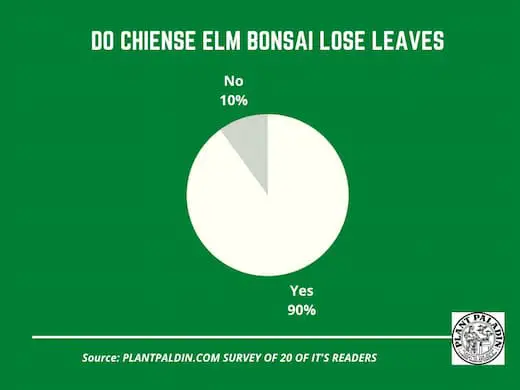
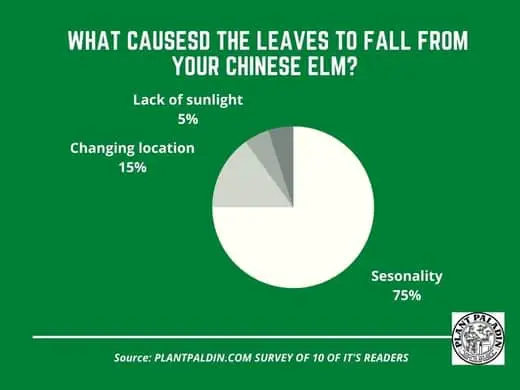
How to care for a Chinese Elm tree?
A lot of you reading this will be wondering exactly how to care for a Chinese Elm bonsai tree, so hopefully, the table below will help:
Chinese Elm Bonsai tree Requirements | Explained |
Water | Once per day in the spring-summer or if kept indoors. Once per week if kept outdoors during the winter. Only water if dry to touch. |
Sunlight | 6 hours of direct sunlight in the summer. LED grow light can also be used. |
Temperature | Between 60 degrees F and 100 degrees F |
Fertilizer | Once per month during the spring and summer. No fertilization is required in the fall or winter. |
Repotting | Once every 2 to 3 years in the first 10 years. You can then report once every 5 years |
Placement | Can be placed outdoors in direct sunlight or indoors in a bright spot. |
Wire type | Both copper and aluminum wire can be used. |
Time to grow from scratch into maturity | 8 to 12 years to reach full maturity |
Potting soil | An inorganic Akdama, volcanic ash soil mix works best. |
Growth type | Fast-growing, averaging 12 to 36 inches of growth per year. |
Size | Average store-bought trees are size is one or two-handed bonsai trees - 3 to 10 inches in size, 2 to 8 inches wide |
Lifespan | 50 to 150 years |
Fruit | None |
My top picks for the gear you will need!
So like I mentioned earlier, over the past three years of running PlantPaladin, hundreds of people have asked me for my recommendations on the best bonsai gear on the market.
Having spent thousands of dollars on bonsai items these past few years and tested at least 100 bonsai-specific products, I’ve listed my favorite products below – All of which I highly recommend and think you can get great value.
They can purchase directly by clicking the link to take them to Amazon.
Bonsai Tool Set: One of the significant challenges I’ve had is finding a toolset that was not only durable but didn’t break the bank. SOLIGT has recently developed a fantastic bonsai tool set that covers all the tools you need to trim, prune, and repot your trees. – You can grab it here.
Complete Bonsai Set: Many of you will want to grow your bonsai trees entirely from scratch, but finding the varicose seeds, pots, and other items in one place can be challenging. Leaves and Sole then have created a complete bonsai set that I’ve personally used that ticks all the boxes. You can grab it here.
Bonsai wire: The number of times I’ve run out of wire for my bonsai or purchased cheap bonsai wire that doesn’t do the job is embarrassing for me to admit. After a lot of trial and error, I found that using Hotop’s aluminum bonsai wire is one of the best options on the market. This can easily be used for both indoor and outdoor bonsai. You can grab it here.
This post was written by Fehed Nicass who has been passionate about bonsai for over 3 years. He currently resides in the UK and works in sales.

